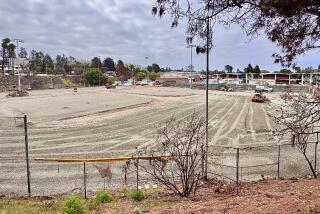Ground Broken Despite Mission School Dispute
- Share via
VENTURA — Despite a growing debate over Chumash artifacts found behind Mission San Buenaventura, officials on Wednesday broke ground for a 750-seat auditorium and 345-pupil elementary school.
All 210 students of Holy Cross School--or at least the ones who weren’t busy fidgeting--lifted their young voices in song, and regional Bishop Thomas Curry offered a blessing of holy water and prayers for the $5.5-million project to proceed smoothly.
Mayor Jack Tingstrom and other officials praised plans for the 40,000-square-foot school and acoustically designed, multipurpose auditorium, saying they will provide a cultural center and a solid anchor for Ventura’s downtown redevelopment.
And with fund-raising already topping $3 million, campaigners such as former U.S. Rep. Robert Lagomarsino said it should be easy to reach their goal.
Msgr. Patrick O’Brien told guests at the groundbreaking he was delighted to reach this stage.
“We are standing on the shoulders of our predecessors, the peace-loving Chumash who inhabited these hills, the blessed Junipero Serra” who founded California’s missions, and all the Mission San Buenaventura pastors since then, O’Brien said.
“Let’s go forward with the motto of our founder,” he said. “Siempre adelante--’Always go forward.’ ”
*
But a dispute still stewing between mission officials and archeologists could stall construction.
Nearly a dozen Chumash representatives stood in front of the mission during the groundbreaking ceremony Wednesday, collecting signatures on a petition opposing the school construction.
The petition demands that the mission guarantee that the site will not be harmed by excavation and that if harm cannot be avoided, a complete record of the archeologists’ findings be given to the Chumash of Ventura County, said Regina Wilcox, a Chumash activist.
Beads, bowls, bones and other artifacts have been found at the site, which needs further study, she said.
“I don’t expect anything’s going to stop the Catholic Church from doing what it wants to do,” Wilcox said. “But the more the public’s aware that things like this happen, the more it gets added to the record, and maybe the protocol will be followed down the line.”
Chief archeologist Gary Stickle walked off the job last week after complaining that O’Brien was pushing dig team members to work so quickly that they did not have enough time to do their job in a professional manner.
*
And several people have complained that Redstar, the Native American monitor overseeing the thoroughness of the archeological dig, is not qualified for the job because he does not have enough Chumash blood. He told The Times he is one-eighth to one-quarter Chumash.
But California law does not require monitors to be of any particular heritage, said Tom Figg, planning and redevelopment manager for the city of Ventura.
The law only requires the mission to spend half a percent to three-quarters of a percent of the total $5.5-million project cost on archeological investigation and mitigation, Figg said.
Mission officials say they have already spent more than $100,000, which is well over the required amount.
The only other legal requirement is that mission officials provide a complete site analysis, lab analysis of artifacts and monitoring plan for the ongoing school site excavation, Figg said. Then, providing no Chumash burials or other significant sites are found, work on the buildings can begin, he said.
Figg said he is waiting for opinions from the Native American Heritage Commission and the state Office of Historic Preservation on whether the archeological dig has met its legal requirements so far.
Once the dispute is settled and the final report is filed satisfactorily, the city will issue a building permit, Figg said.
“In our view, the issue is really between two parties, the archeologist and the mission,” he said. “Our understanding is they have agreed to meet today [Thursday] to try to lay out the issues as each sees them. It would be our hope that some sort of solution could be worked out.”
*
For his part, Redstar says the archeology team found only an old tiled mission floor, some aqueducts, broken glass and a midden heap, or garbage pile of the type common to the California missions.
“As far as I know, we haven’t found anything at this mission that was outright historic,” said Redstar, whom the mission hired to meet a state requirement that there be a Native American monitor watching the dig.
Stickle, the head archeologist, could not be reached Wednesday for comment.
O’Brien, who has pushed for several years to get the school project underway, said after the ceremonies Wednesday, “I’m confident we can overcome our particular difficulties. I’m quite pleased with the effort we’ve put into it. The mission has nothing to hide.”
The new school building and auditorium would mark a new era for the mission, allowing Holy Cross School to expand its K-through-8 classes to include a preschool and accommodate more students.
Once the archeological issues are resolved, a yearlong project would begin to build the auditorium.
The school would then move into temporary classrooms in its main hall and permanent classrooms in its basement. And workers would spend another year razing the existing two-story Holy Cross School building and replacing it with a three-story school nearly twice the size, said Curtis Cormane, architect for the project.
Meanwhile, the fund-raising campaign--a fairly low-key affair until now--will accelerate to raise the remaining $2.5 million, Lagomarsino said.
Holy Cross Principal Dorothy Reed said the school may even enlist the pupils’ help in soliciting donations through programs allowing donors to “adopt” a desk, chair or student.
“We were waiting for the groundbreaking,” she said. “We do have a lot of plans for the children to help us.”
More to Read
Sign up for Essential California
The most important California stories and recommendations in your inbox every morning.
You may occasionally receive promotional content from the Los Angeles Times.













